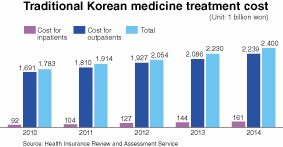More South Koreans have been visiting traditional Korean medicine clinics lately, while the industry has been pushing to expand its business into conventional medical services in felds such as dermatology, government data showed Tuesday.
According to data, Koreans spent 2.4 trillion won ($2.2 billion) last year on traditional Korean medical treatment, such as acupuncture. The spending has increased significantly since 2010, with an average annual growth rate of 7.7 percent per year, according to the state-run Health Insurance Review and Assessment Service.
One of the biggest factors behind this growth is the country’s growing elderly population, many of whom prefer traditional Korean medicine over Western medicine, according to the government.
More than 60 percent of Koreans who visited traditional medicine clinics last year were aged 50 or older, and the largest number of patients sought help for back pain and hip or lumbar dislocations.
“Traditional Korean medicine has been traditionally preferred by the elderly for pain-related conditions because it offers non-surgical treatment options, such as acupuncture,” said Ji Eun-young from the Health Insurance and Assessment Service.
“Since the country’s baby boomers, who are currently aged 51 to 59, are entering their 60s this year, the spending on traditional Korean medicine is inevitably rising,” said Kim Han-jung, another official at the agency. “The population of baby boomers is as big as the total elderly population.”
The largest number of all patients ― 60 percent ― chose to receive acupuncture, while 16.2 percent sought cupping treatment, a therapeutic technique which involves suction. Among all patients, 64 percent were women.
The number of traditional medicine clinics and doctors have also increased since 2010. The number of clinics increased from 12,637 on 2010 to 14,093 last year, while the number of doctors rose from 20,356 to 23,653 in the same period.
Some in the health sector say the reason many elderly patients prefer traditional Korean medicine has to do with Korea’s low rates of prescriptions of pain killers, including opioids.
Koreans are prescribed less than 47 percent of the opiate consumption level that the WHO considers adequate for chronic pain relief, according to 2010 data.
“As many elderly patients often fear the adverse effects of opioids, they look for other options, such as acupuncture or hot springs,” said Lee Jong-ho, director of international drugmaker Mundipharma’s Korea and Southeast Asia division.
Prior to the release of government data, there had been an intense debate whether or not it was ethical ― or even safe ― for traditional Korean doctors to use conventional medical equipment, such as ultrasound and X-ray machines.
Currently, the Korean law allows traditional medical professionals to use all non-traditional medical scanning equipment except for MRI and CT scanners.
However, a number of traditional doctors have faced lawsuits filed by doctors who practice Western medicine, who claim it is dangerous for those who are not trained in medical science to use any conventional medical equipment. According to Lee Jin-woo, who oversees Korean traditional medicine policies at the Health Ministry, a number of cases have been won by conventional doctors in the past ― which eventually prohibited the specific traditional doctors from using certain devices.
As a part of its deregulation agenda, the Office of Government Policy Coordination announced earlier this year that it was considering a law that lets traditional doctors to use non-traditional medical devices without having to worry about being sued by regular physicians.
The announcement triggered fierce opposition from the Korean Medical Association, which represents 100,000 physicians.
“By considering to allow traditional doctors to use medical equipment without any regulations, the government is putting the citizens’ health and safety at risk,” the KMA said in a recent statement.
The Association of Korean Medicine, a representative body of Korean traditional doctors, said the latest statistics proved that Koreans needed more traditional medicine that is combined with modern technology.
“The demand is certainly there, and we are aware that the majority of patients who come to us are those with joint problems or suffering from chronic pain,” said Kim Ji-ho, the spokesman of the organization.
“Once we are allowed to use X-ray machines and ultrasound, we would be able to offer more quality services to those with joint or muscle problems, as it will make it easier for us to make a more accurate diagnosis.”
In spite of the increase, however, the total amount spent on traditional Korean medical care only accounts for 4 percent of total medical spending last year, according to the Health Ministry.
By Claire Lee (
dyc@heraldcorp.com)





![[Exclusive] Hyundai Mobis eyes closer ties with BYD](http://res.heraldm.com/phpwas/restmb_idxmake.php?idx=644&simg=/content/image/2024/11/25/20241125050044_0.jpg)
![[Herald Review] 'Gangnam B-Side' combines social realism with masterful suspense, performance](http://res.heraldm.com/phpwas/restmb_idxmake.php?idx=644&simg=/content/image/2024/11/25/20241125050072_0.jpg)

